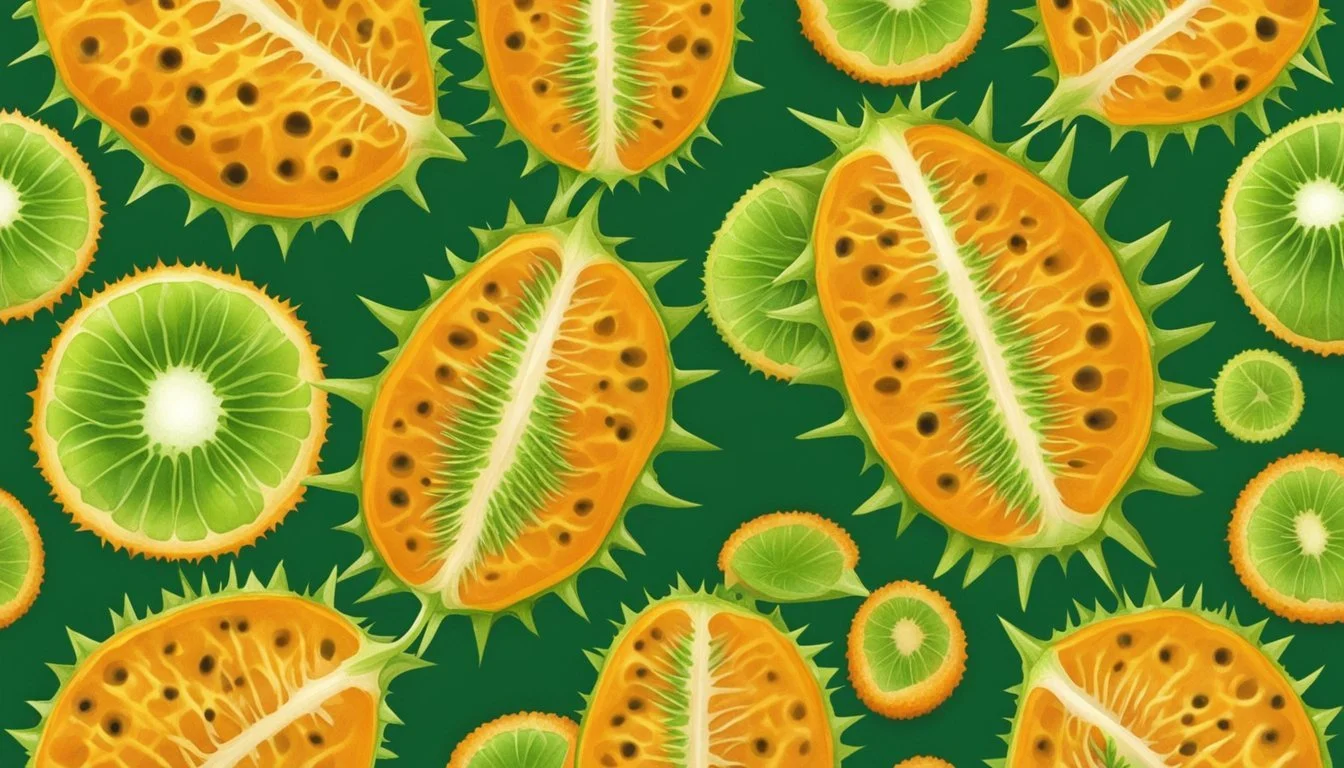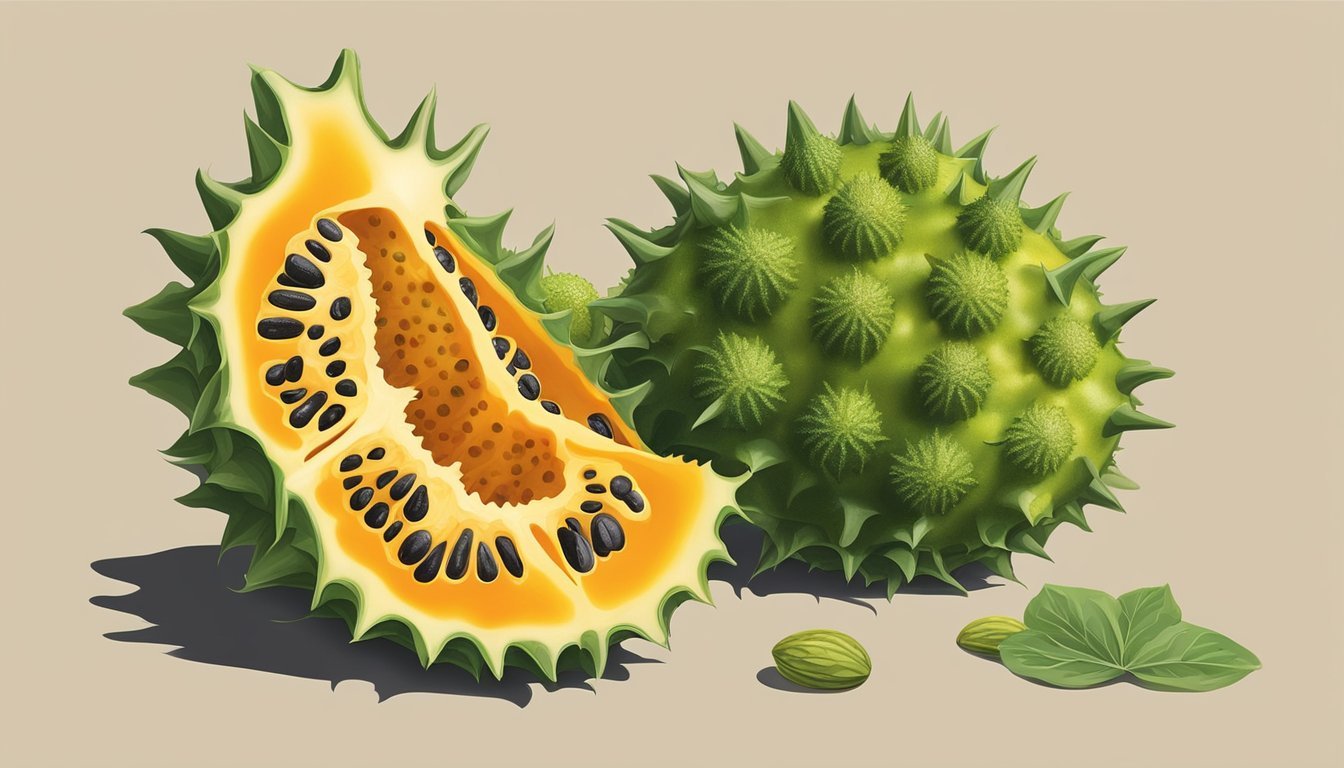How do you eat a Kiwano
A Guide to Enjoying Horned Melon
The kiwano, also known as the horned melon, is a vibrant and exotic fruit that catches the eye with its bright orange skin and horn-like spiky protrusions. Originating from Africa, the kiwano is not just praised for its striking appearance but also for its nutritional benefits. It contains a variety of essential nutrients including vitamins, minerals, and antioxidants, making it a healthy addition to one's diet.
Eating kiwano can be a unique experience due to its gelatinous green flesh scattered with cucumber-like seeds. The inner contents of a kiwano melon are often compared to a mix of cucumber, zucchini, and kiwifruit, though it has a mildly sweet and slightly tangy flavor that is uniquely its own. This fruit is versatile and can be eaten raw or included in dishes and desserts for a tropical twist.
To consume kiwano, one could simply slice it lengthwise and squeeze the jelly-like substance out, or scoop it with a spoon, and eat it directly. The seeds of the kiwano are edible and provide a crunchy texture to the soft and succulent flesh. The fruit can also be chopped into cross-sections, if preferred. With its refreshing taste and ease of preparation, kiwano serves not only as a snack but also as an intriguing addition to salads, smoothies, and garnishes for a variety of dishes.
Origins and History
The kiwano, scientifically known as Cucumis metuliferus, is an intriguing fruit with an extensive history rooted in Africa. It thrives in a variety of climates and has piqued global interest for its distinctive appearance and nutritional benefits.
Native Regions and Cultivation
Kiwano, often referred to as horned melon, originally hails from the semi-arid regions of Southern Africa, predominantly found in South Africa, Namibia, and Botswana. This vine-like fruit, part of the Cucurbitaceae family, adapts well to different environments and has been a source of both food and water for various cultures in these regions.
Suitable Climates: Semi-arid
Primary Regions: Southern Africa
South Africa
Namibia
Botswana
Cultivation practices have historically taken advantage of the kiwano's resilient nature, often thriving in areas with less than optimal farming conditions.
Global Spread
Initially confined to Africa, the appeal of the kiwano has led to its cultivation in other parts of the world. Notably, its introduction into Australia and New Zealand opened up new markets and agricultural opportunities. In these regions, the kiwano is often grown in controlled environments to replicate its native growing conditions.
Further spread to the United States has seen the kiwano being embraced as an exotic fruit, often cultivated in California and other warm states. The fruit's unique qualities have made it popular among chefs and food enthusiasts, contributing to its increased presence in western fruit markets.
Notable New Regions:
Australia
New Zealand
United States (California)
Thus, the kiwano has transcended its native origins to become a globally recognized fruit enjoyed in various cuisines and valued for its diverse culinary applications.
Nutritional Profile
Kiwano, also known as horned melon, possesses a distinctive nutritional makeup, featuring a balanced blend of macronutrients and a wide spectrum of vitamins and minerals that support overall health.
Macronutrients
Calories: A typical kiwano melon provides approximately 103 calories per one-cup serving.
Protein: There is an average of 3.72 grams of protein per fruit, accounting for about 16% of the total caloric content.
Fat: One serving of kiwano has roughly 2.9 grams of fat, contributing to its nutrient density.
Carbohydrates: Kiwanos contain about 17.6 grams of carbs, with a significant portion comprising non-sugar compounds.
Vitamins and Minerals
Vitamin C: A potent antioxidant, vital for immune system function.
Magnesium: An essential mineral for muscle and nerve function, among other bodily processes.
Iron: Crucial for the formation of hemoglobin, which carries oxygen in the blood.
Vitamin A: Important for vision, the immune system, and reproduction.
Vitamin B6: Involved in brain development and keeping the nervous and immune systems healthy.
Phosphorus: Supports bone health and energy production.
Zinc: Necessary for immune function, wound healing, and DNA synthesis.
Potassium: Helps to regulate fluid balance, muscle contractions, and nerve signals.
Calcium: Essential for bone health and proper functioning of the heart, muscles, and nerves.
The inclusion of these nutrients makes kiwano a valuable addition to a health-conscious diet.
Health Benefits
The kiwano melon offers a variety of health benefits that stem from its high water content and rich supply of essential nutrients. It serves as a hydrating fruit with antioxidants and vital minerals that contribute to overall health, particularly in supporting bone integrity and blood health.
Hydration and Electrolytes
Kiwano is composed of a significant amount of water, making it an excellent choice for hydration. The high water content, alongside a noteworthy presence of electrolytes such as potassium and magnesium, helps maintain fluid balance in the body. This aspect is particularly beneficial for those looking to replenish their hydration levels in hot climates or after exercise.
Water Content: High
Electrolytes: Potassium, Magnesium
Antioxidant Properties
The fruit's vibrant color hints at its abundance of antioxidants like alpha-tocopherol and beta-carotene, compounds known for protecting cells against oxidative damage. Kiwano's antioxidants may contribute to muscle and nerve health, and due to their role in scavenging free radicals, they might also support the immune system and lower the risk of chronic diseases.
Antioxidants: Alpha-tocopherol (Vitamin E), Beta-carotene
Supporting Bone and Blood Health
In addition to its hydrating and antioxidative qualities, kiwano contains essential minerals like calcium and iron, which are crucial for bone health and red blood cell production, respectively. The low glycemic index of the fruit suggests that it can be a healthy addition to the diet of individuals monitoring their blood sugar levels.
Bone Health: Calcium content
Blood Health: Iron content
Glycemic Index: Low
Selecting and Storing
When choosing a kiwano, one should look for certain visual cues indicating ripeness, and knowing proper storage techniques ensures the fruit maintains its quality.
Identifying Ripe Kiwano
A ripe kiwano melon will exhibit a bright orange color on its outer rind, signifying it's ready to be eaten. The skin should appear firm yet give slightly under pressure, indicating it's at the peak of its ripeness. One should avoid kiwanos with overly soft spots or an entirely green hue as these are indicators that the fruit is either overripe or not yet matured.
Storage Tips
After selecting a ripe kiwano, it can be stored at room temperature until it reaches its desired ripeness. Once it has fully ripened, the kiwano should be kept in the refrigerator to extend its shelf life. If one cuts the kiwano, the remaining portions should be wrapped tightly and refrigerated, ideally consumed within a few days for the best taste and texture.
Preparation and Consumption
Proper preparation of kiwano melon enhances its enjoyment, with emphasis on safe cutting methods and the various ways to consume the edible seeds and pulp.
Cutting Techniques
To begin, one must clean the kiwano melon to remove any debris from the spiny, orange rind. The melon is then ready to be cut. A common technique is to slice the fruit in half across the equator to create two halves. Another method is to cut the kiwano lengthwise, which may make the seeds and pulp more accessible for some eating methods.
Scooping and Eating Methods
The kiwano melon's seeds are edible and surrounded by a bright green, jelly-like pulp. One can consume the fruit by using a spoon to scoop out the pulp and seeds directly from the rind. Alternatively, the cut halves can be squeezed to release the pulp into a separate container or directly into the mouth, if one prefers to drink the juice and pulp. The rind itself is not edible, so care should be taken to avoid ingesting it.
Culinary Uses
Kiwano, with its bright orange skin and gelatinous green-tinged pulp, is a fruit that adds a tropical flair and a nutritional boost to a variety of dishes. It's known for its cucumber-like taste and hint of banana-like sweetness.
Recipes and Pairings
Kiwano can be used in recipes ranging from sweet to savory. Its low calorie content and richness in minerals make it a healthy addition to any meal. To incorporate Kiwano in fruit salads, simply scoop out the pulp and mix it with other tropical fruits such as banana and passion fruit. Enhance the flavor with a squeeze of lime for added zing.
Smoothies: Blend the fruit's pulp with a combination of other fruits like banana and passion fruit for a nutritious drink.
Salads: Dice the pulp and fold into a cucumber and banana salad, possibly with a drizzle of lime or lemon juice.
Salsa: A Kiwano salsa can include a blend of its pulp, cilantro, onions, and a touch of lime juice, perfect beside grilled fish or chicken.
Innovative Serving Ideas
The unique look and texture of Kiwano also lend it to innovative serving ideas.
Garnish: Its vibrant pulp can serve as an eye-catching garnish for cocktails and ice cream.
As a filling for desserts, Kiwano can be combined with sugar and used in sorbets or set in gelatinous concoctions.
Cheese Platters: Pair the pulp with a selection of cheeses for a fresh, fruity counterpoint.
Using the Kiwano for its decorative potential and flavor profile encourages culinary creativity and adds a refreshing twist to traditional dishes.
Cultural Significance
The Kiwano, also known as horned melon, has woven itself into the fabric of various cultures, both as a tropical fruit with distinct uses and as an icon in media that often symbolizes exoticism and the unordinary.
Literary and Media References
In the realm of media, the Kiwano has made notable appearances, particularly in science fiction. A memorable example is its inclusion in the Star Trek universe, where it was featured as a food item in the Star Trek: Deep Space Nine series. This usage underscores the fruit's association with the unusual and the futuristic, often standing in as a representation of alien cultures within the genre.
Its distinct visual appearance, reminiscent of a combination of a blowfish and a cantaloupe (how long does cantaloupe last?), often lands it roles that suggest otherworldliness. In terms of literature, the Kiwano is less commonly referenced but when it is, it's often to add a touch of the exotic to a setting, alongside other tropical fruits like dragon fruit and passionfruit.
The Kiwano, with its origins in the Kalahari Desert, is not just a staple in science fiction but is also utilized as specialty produce in various culinary circles, appreciated for its unique flavor and texture. As consumers become more adventurous in their taste preferences, Kiwano fruits are emerging as a specialty item in markets that prize novelty and variety.
Buying Guide
When selecting kiwano melons, it's important to consider freshness and ripeness to ensure the best taste and texture experience from this exotic fruit.
Where to Find Kiwano
Kiwano melons, also known as horned melons, are typically found in the exotic or specialty produce section of grocery stores. They originate from Africa but are now grown in various parts of the world including New Zealand and Australia. When shopping, one may find kiwanos at farmers' markets, specialty food shops, and sometimes in larger supermarket chains that carry a diverse range of produce.
When assessing kiwano fruits for purchase, here are key features to look for:
Color: A ripe kiwano melon should have a bright orange skin. A greenish hue indicates that the fruit is underripe.
Texture: The skin should be firm with slight give upon gentle pressure. Overly soft spots may signal overripeness or bruising.
Spikes: The characteristic spikes of the kiwano should be intact, not broken.
Weight: It should feel heavy for its size, which suggests it's juicy on the inside.
Aroma: A ripe kiwano may emit a subtle, sweet, and fresh fragrance.
Remembering these tips will help to ensure a pleasant experience when eating kiwano melons.
Nutrition Myths and Facts
The kiwano, also known as the horned melon, has sparked discussions on its nutritional profile, often leading to misconceptions. This section will clarify common myths and present scientific evidence to provide a clear understanding of kiwano's nutritional benefits.
Common Misconceptions
Low in calories: A common myth is that the kiwano is high in calories. In reality, it is quite low in calories, providing roughly 103 calories per one-cup serving.
Antioxidants: While some may underestimate this fruit, the kiwano is a good source of antioxidants, which are compounds that play a role in protecting the body from damage caused by harmful molecules.
Texture and Flavor: The kiwano's texture may lead some to think it’s bland, but the fruit is actually refreshing with a mildly sweet and tangy flavor.
Vitamins: There’s a misconception that exotic fruits like kiwanos are not as nutritious as more common fruit, yet the kiwano contains vitamin C and vitamin A among others.
Scientific Evidence
Carbohydrates: Scientific analysis confirms kiwano is composed of about 16g of carbs per fruit, which includes a minimal amount of natural sugars such as fructose and sucrose.
Blood Sugar: Its low sugar content suggests that the kiwano might have a minor impact on blood sugar compared to fruits with higher sugar content.
African Horned Cucumber/Melon: The kiwano is native to Africa and is rich in seeds, which contributes to its protein content, a nutrient that is not typically high in fruit varieties.
FAQs
This section addresses commonly asked questions about the kiwano melon, providing clear and straightforward answers on how to eat it and its nutritional benefits.
Questions and Answers
Q: What is a kiwano melon and where does it come from? A: The kiwano melon, also known as the horned melon, is a unique fruit originating from Africa. Its bright orange skin is lined with small spikes, and it is typically grown in the US during the summer months.
Q: How can one eat a kiwano melon? A: To eat a kiwano melon, slice it in half and scoop out the green, jelly-like flesh with a spoon. This fruit can be eaten raw, and the cucumber-like seeds inside are also edible.
Q: Can you eat the skin of a kiwano melon? A: The skin of the kiwano melon is generally not eaten due to its toughness. It is recommended to consume only the fruit's flesh and seeds.
Q: What does kiwano melon taste like? A: The taste of kiwano melon is often described as a combination of cucumber, zucchini, and a slight hint of banana. It has a refreshing flavor with a mild sweetness.
Q: What are the nutritional benefits of kiwano melon? A: Kiwano melon is low in fat and calories, and it contains essential nutrients such as vitamin C, magnesium, iron, calcium, and potassium. These contribute to a variety of health benefits, including supporting immune function and bone health.
Q: Can you freeze kiwano melon? A: Yes, kiwano melon can be frozen. Scoop out the flesh and store it in an airtight container before freezing to preserve its taste and texture for later use.
Q: Is kiwano melon suitable for adding to other dishes? A: Absolutely. Kiwano can be a flavorful addition to salads, smoothies, and desserts. A sprinkle of salt can enhance its flavor when consumed raw.





